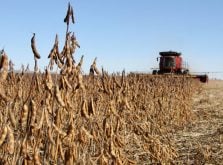The organization in charge of Alberta turkey production wants producers to move their flocks from outside to inside a barn to reduce the risk of avian influenza.
“Because free range and birds that are raised outdoors provide the most risk, we want them to try and phase out that aspect of their operation,” said Dawn Ius, manager of marketing and communications with Alberta Turkey Producers.
Of the 63 regulated turkey producers in the province, the organization is asking the 13 that raise flocks outside to have at least some protective barrier or netting between their farmed turkeys and wild birds to reduce the risk of contacting avian flu.
Read Also

Manitoba extends Crown land rent freeze
Manitoba government links the continued rental rate freeze on grazing and forage leases to economic and environmental challenges facing the industry
More than 19 million birds in British Columbia’s Fraser Valley on 39 farms will be slaughtered because of avian influenza. While there is no definitive answer for how it spread to the farms, it is believed to be spread by wild birds, infected feed, manure, contaminated clothing or footwear, water or commercial bird catching equipment.
Ius said the turkey board is not mandating all turkey operations be moved indoors but that has happened in some American states.
“We don’t know what the future will be,” said Ius.
Lloyd Johnson, executive director of the Alberta Poultry Producers, said there is no move to force outdoor flocks indoors.
“Our only message is to understand and take more precaution.”
Ron Hamilton, who raises free-range turkeys and chickens on his farm at Armena, Alta., said the fear of avian flu is just a step toward eliminating outdoor bird production.
“It’s not just an overreaction, it’s a planned reaction,” said Hamilton, who raises 30,000 pasture-raised chickens and 300 pasture-raised turkeys on his organic farm south of Edmonton.
Less concentrated
Unlike southern B.C., Alberta doesn’t have a massive concentration of poultry or the same risk for avian flu, said Hamilton.
He believes good bio-security and an on-farm food safety plan for raising chickens outdoors poses no greater risk for the birds, which have become popular with consumers.
This year he plans to add a chlorination and filtration system to his birds’ water supply, and add owl statues to his dugout to keep wild birds from landing on his water source.
His food safety plan includes raising the birds on dry clean shavings, feeding good feed, reducing traffic through the barns and having all farm visitors sign a log book.
Hamilton said there is still a need to get the word out to small outdoor chicken producers about the basics of a security system to help ensure the health of the birds.
Stella Purdy, president of the Fraser Valley Poultry Fanciers Association in Abbotsford, B.C., said it’s ludicrous to eliminate small, backyard poultry flocks. Instead, she said, officials should stop the spread of avian flu by targeting the large commercial operations, where she believes it started.
“It spread from the commercial barns. It’s a commercial barn problem,” said Purdy, whose entire flock of heritage shows birds was destroyed April 1, even though they tested negative three times. The birds were destroyed because they were in the middle of the hot spot of avian influenza.














